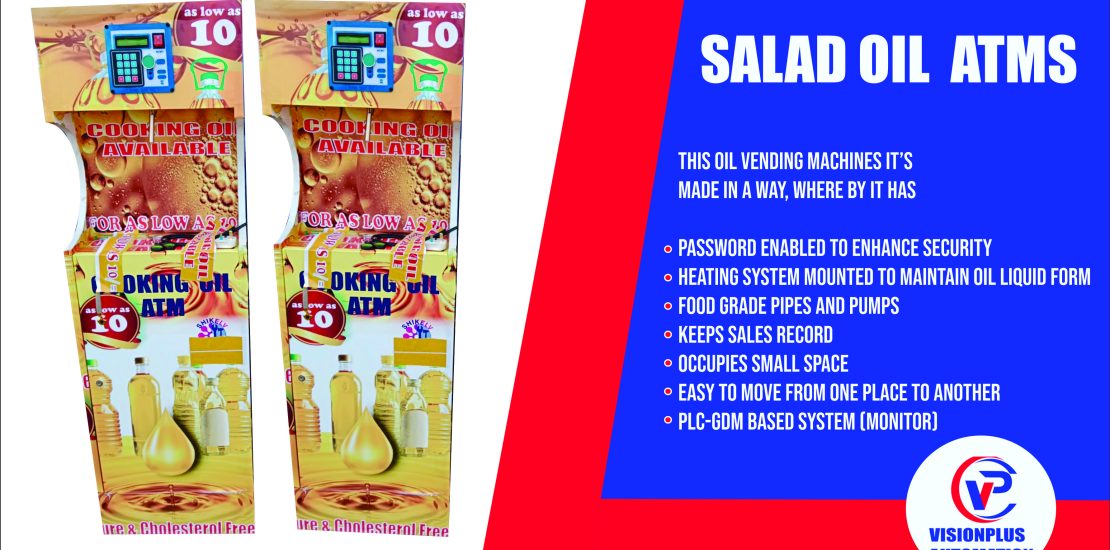- November 22, 2023
- Posted by: VisionPlus Automation
- Category: cooking oil vending machine

A Guide to Investing in Cooking Oil Vending Machines
A Guide to Investing in Cooking Oil Vending Machines
Introduction
Investing in cooking oil vending machines presents a unique and promising opportunity in the realm of automated retail. As culinary habits evolve and consumers seek convenience, vending machines offer a practical solution for accessing cooking oil. This essay provides a comprehensive guide for entrepreneurs considering investing in cooking oil vending machines, outlining key steps, considerations, and strategies to navigate this emerging market successfully.
1. Market Research:
Before diving into any investment, thorough market research is essential. Understand the demand for cooking oil in the target location. Identify high-traffic areas, such as markets, residential neighborhoods, or commercial centers, where the installation of vending machines can yield maximum visibility and accessibility.
2. Regulatory Compliance:
Familiarize yourself with local and national regulations related to food and vending operations. Ensure that your cooking oil vending machines comply with health and safety standards. This may involve obtaining permits, adhering to hygiene regulations, and addressing any legal requirements specific to vending operations.
3. Selecting the Right Machines:
Choose vending machines that meet the specific needs of the cooking oil market. Look for machines equipped with advanced features such as accurate measurement capabilities, multiple payment options, and digital interfaces. Consider the capacity of the machines and whether they can accommodate various container sizes to cater to diverse customer preferences.
4. Sourcing Cooking Oil:
Establish relationships with reliable cooking oil suppliers. Ensure that the oil sourced meets quality standards and adheres to health regulations. Negotiate favorable terms with suppliers to maintain cost-effectiveness, a crucial factor in the success of the vending business.
5. Location Selection:
The success of a vending machine business often hinges on strategic location selection. Choose high-traffic areas where consumers are likely to need cooking oil urgently. Partnering with local businesses or securing vending spots in residential areas with limited access to convenience stores can enhance the visibility and profitability of your vending machines.
6. Marketing and Branding:
Invest in effective marketing strategies to create awareness about your cooking oil vending machines. Develop a brand identity that communicates reliability, quality, and convenience. Utilize various channels, including social media, local advertising, and partnerships with grocery stores, to promote your vending business.
7. Pricing and Payment Options:
Determine competitive and transparent pricing for your cooking oil. Consider the local market rates, production costs, and the value your vending machines provide to customers. Ensure that your machines accept various payment methods, including cash, cards, and digital payments, to accommodate the diverse preferences of consumers.
8. Maintenance and Customer Support:
Regular maintenance of your vending machines is crucial for ensuring uninterrupted service. Establish a system for routine checks, cleaning, and addressing any technical issues promptly. Provide customer support channels, such as a helpline or email, to address inquiries, feedback, or concerns from users.
9. Sustainability Practices:
Consider implementing sustainable practices in your vending business. Encourage customers to use refillable containers, reducing single-use packaging and contributing to environmental responsibility. Highlighting your commitment to sustainability can also enhance the appeal of your vending machines to environmentally conscious consumers.
10. Monitoring and Adaptation:
Continuously monitor the performance of your cooking oil vending machines. Track sales data, customer feedback, and market trends. Be prepared to adapt your strategies based on evolving consumer preferences, technological advancements, and changes in the competitive landscape.
Conclusion: A Recipe for Success
Investing in cooking oil vending machines requires a blend of strategic planning, market insight, and operational efficiency. By conducting thorough market research, ensuring regulatory compliance, selecting the right machines, sourcing quality cooking oil, strategically placing vending machines, implementing effective marketing, setting competitive pricing, providing excellent maintenance and customer support, embracing sustainability practices, and remaining adaptable to market dynamics, entrepreneurs can create a recipe for success in the growing market of automated cooking oil distribution. As convenience becomes a driving force in consumer behavior, investing in cooking oil vending machines not only taps into a practical market need but also positions entrepreneurs at the forefront of an innovative and lucrative business opportunity.
